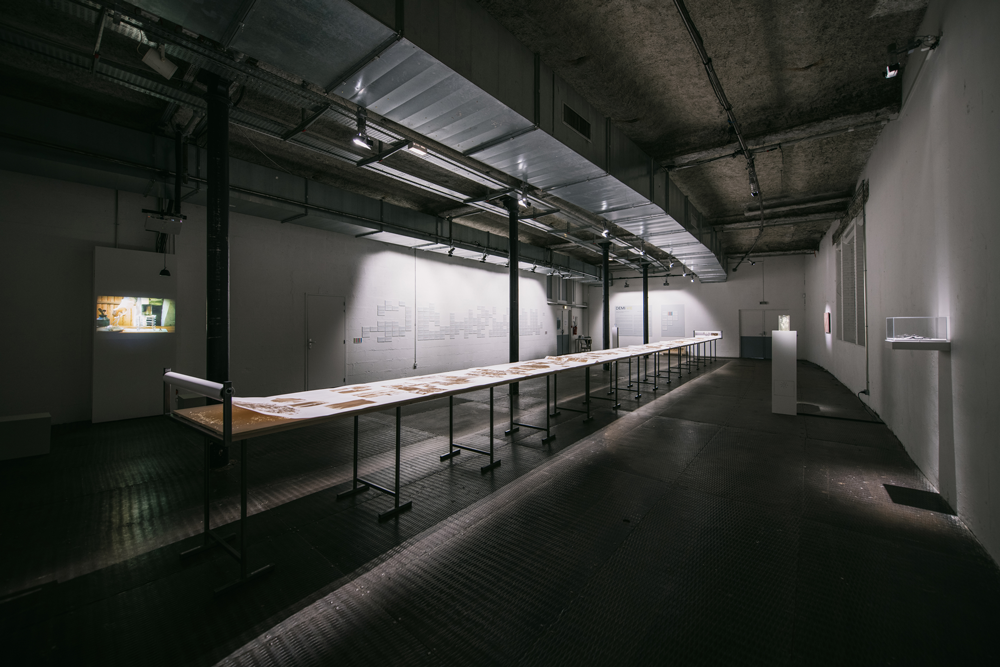
Archives Gammas
Mounted on industrial trestles and planks of wood, is an enormous roll of paper stretched over ten to fifteen metres. From a far, it looks like an ancient manuscript, or a sacred scripture found in a cave in the desert. But when one starts to lean in, one discovers, as if burnt by acid or irradiated (into the paper?), all kinds of landscapes, strange machines, ruines, bacteria, satellites, gloomy looking houses, deserted cities, buildings on fire, or futuristic looking cities. All in all, about one to two hundred images are displayed (‘that have been laser-burnt’ tells us Perraud, ‘because rays, just like radioactivity, make the heart of things melt’) that follow no logical order and are open to interpretation. On the handout, is some information about the artwork. An old power plant converted into a theme park, a mushroom that feeds on uranium, the blistered face of a young man, who we understand, tried to build a nuclear reactor in his bedroom, the ‘radium dance’ that Loïe Fuller performed in front of the Curie couple. It all seems so unreal and yet, it is all absolutely true. All these facts have been gathered by the artists along with an interdisciplinary college (made of scientists, artists, curators, intellectuals and scholars), who have helped them examine the actes of this incredible nuclear civilisation. “Radioactivity exceeds in all ways what man is able to master’. It’s a bottomless well for stories, that borderline fantasy, tells us Kebabdjian. Rays irradiate our landscapes, penetrate our existence, bend our field of knowledge, redefine the way we see the world and the thought of what we will leave behind us on this Earth. It is this human comedy that we have sought to lay down on this large parchment. As though we were observing a bygone era from a distant future.” The viewers circle around this document. Searching for meaning, trying to read it, interpret it, like an ancient scripture, who by inversion, might give shape to the future we find so hard to conceive. Viewers drift towards the second room.
Mounted on industrial trestles and planks of wood, is an enormous roll of paper stretched over ten to fifteen metres. From a far, it looks like an ancient manuscript, or a sacred scripture found in a cave in the desert. But when one starts to lean in, one discovers, as if burnt by acid or irradiated (into the paper?), all kinds of landscapes, strange machines, ruines, bacteria, satellites, gloomy looking houses, deserted cities, buildings on fire, or futuristic looking cities. All in all, about one to two hundred images are displayed (‘that have been laser-burnt’ tells us Perraud, ‘because rays, just like radioactivity, make the heart of things melt’) that follow no logical order and are open to interpretation. On the handout, is some information about the artwork. An old power plant converted into a theme park, a mushroom that feeds on uranium, the blistered face of a young man, who we understand, tried to build a nuclear reactor in his bedroom, the ‘radium dance’ that Loïe Fuller performed in front of the Curie couple. It all seems so unreal and yet, it is all absolutely true. All these facts have been gathered by the artists along with an interdisciplinary college (made of scientists, artists, curators, intellectuals and scholars), who have helped them examine the actes of this incredible nuclear civilisation. “Radioactivity exceeds in all ways what man is able to master’. It’s a bottomless well for stories, that borderline fantasy, tells us Kebabdjian. Rays irradiate our landscapes, penetrate our existence, bend our field of knowledge, redefine the way we see the world and the thought of what we will leave behind us on this Earth. It is this human comedy that we have sought to lay down on this large parchment. As though we were observing a bygone era from a distant future.” The viewers circle around this document. Searching for meaning, trying to read it, interpret it, like an ancient scripture, who by inversion, might give shape to the future we find so hard to conceive. Viewers drift towards the second room.

